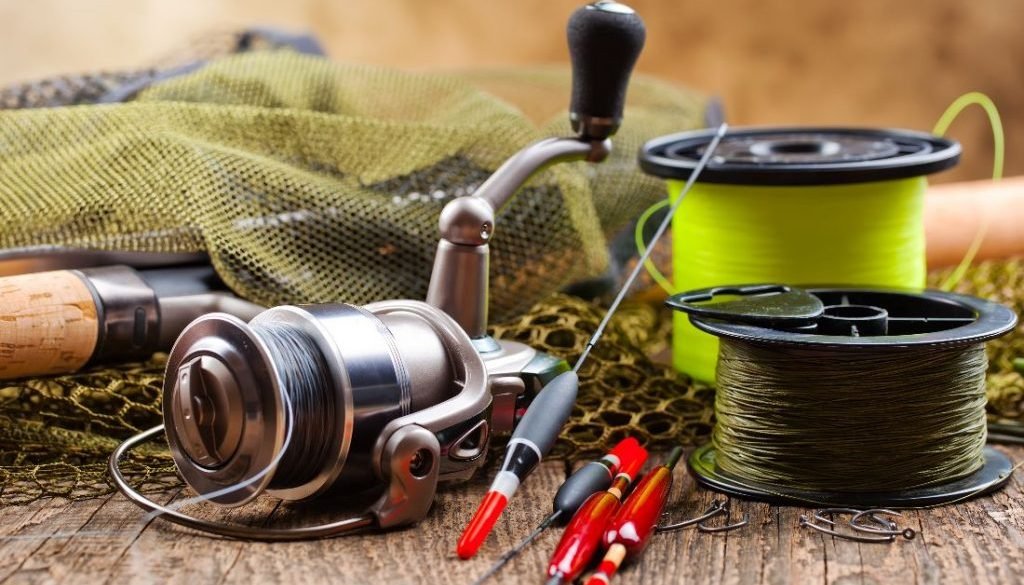Learn How to Spool a Spinning Reel In 3 Steps
If you want to learn how to spool a spinning reel, I have everything you need right here. This skill is a necessary first step to enjoy the sport of fishing. A spinning reel is often the first choice for those who want to begin fishing because this style of reel is easy to use.
Contents
The Steps for How to Spool a Spinning Reel
Before Step #1
The first thing to do is to make sure that the bail is turning in the same direction as the way that the line comes off of the spool. This is essential to spool a spinning reel properly. Next, before you can tie the knot to the empty spool and get started, you need to double-check that the bail is open. After this is complete, you are ready to spool your reel.
Step #1 – Securing the Line to the Spool
The next thing that you will do is thread your line through the bottom guide with the bail open. To do this, you need to start from the top and thread the line towards the reel. When you get the line through, tie the line to the spool securing it with a knot (a uni knot is what the pros use, but an overhand knot will work).
Step #2 – Adding More Line to the Spool
When the line has been secured, you will need to begin adding the line to the spool by rotating the handle, but first, you must close the bail. To make the line spool properly, you will need to keep some tension on the line while spooling it slowly. This can take some practice and will take patience as you will need to go slow as you learn how to spool a spinning reel.
Step #3 – Take Time to Not Overload the Spool
You will want to make sure that you have enough line on the spool, but you also do not want to add too much line on the spinning reel. If you add too much line, there will be some casting issues like backlash, twists, and tangling.
Tips to Help You Have Success with How to Spool a Spinning Reel
Tip #1 – Stick to the Basics
If you are a beginner, you can use an overhand knot in this next step. If you are more experienced, you might want to use a uni knot. Since fishing knots are not simple, it is best to start with what you know. This will make the process simple and much less frustrating for you.
Tip #2 – Consider Having a Friend Help
When it comes to making sure that the spool is thread properly, you might want to have a friend help you the first time. This is just to ensure that the line is entering the spool properly. A friend can help by keeping tension on the line and using a pencil or screwdriver in the filler spool. This will help the job get done right the first time and much quicker than doing it alone.
Tip #3 – How to Avoid Line Twist
Avoiding line twist is easy. Line twist happens when you are reeling the line in the opposite direction of how the line comes off of the spool. You add a line twist with each turn when you do this.
Quick Pros and Cons of Different Types of Fishing Lines
There is no one type of fishing line there are many different types. The following is all of the information that you need to pick the right fishing line for your needs. You will want to get the right type of line for your fishing needs before you learn how to spool a spinning reel.
Also Read: All Fishing Reels Posts
Monofilament Lines
Pros
- Most common type of mono line.
- Made from a stretched plastic that has been stretched into one long line.
- Very reliable choice.
- Easy to use.
- Cheap.
- Holds knots well.
- Available in colors for visibility.
Cons
- Less precision.
- Does not work with bottom baits.
- Doesn’t last long.
- Much weaker than other choices.
Fluorocarbon Lines
Pros
- Made from a stretched plastic that is denser than monofilament.
- Invisible underwater.
- Very resistant to abrasion.
- Lasts very long compared to other lines.
- High shock strength.
- Gives feedback with slack.
Cons
- Knots are more likely to fail.
- Tangles and kinks are easily found.
- Very expensive.
- Works better with experienced fishers.
Also Read: Piscifun Carbon X Spinning Reel Review
Copolymer Line
Pros
- Improved monofilament.
- Made in the same process but with two materials.
- High Shock Strength.
- Very strong.
- More Abrasion resistant.
Cons
- More expensive.
- Can be damaged by the sun.
- Can be damaged by heat.
Braided Line
Pros
- Created by weaving polyethylenes (Dacron, Dyneema, and Spectra).
- Very thin line that is extremely strong.
- Can be 4 to 16 strands (the more strands the stronger!).
- Flows free without kinking.
- No stretch.
- Complete precision
Cons
- Lower shock strength.
- Easily seen underwater.
- Hard to tie knots.
- Can get cut off by toothy fish.
- Can damage cheaper equipment.
- Most expensive line.
Also Read: Types Of Fishing Reels
Once you know the type of line that is going to work best for the fishing reels that you use, you can learn how to spool a spinning reel.
Final Thoughts on How to Spool a Spinning Reel
Learning how to spool a spinning reel is not too difficult. Once you get the hang of how to put the line on the reel, it will be considerably easier to do the next time.
The basic steps above that teach you how to begin running the line are necessary to guarantee that you have a secure line when you go fishing. This will also help you to have more success and fewer chances of a lost line.
While it might take a few times to feel confident, learning how to spool a spinning reel is a skill that you will use throughout your life as you enjoy fishing.




